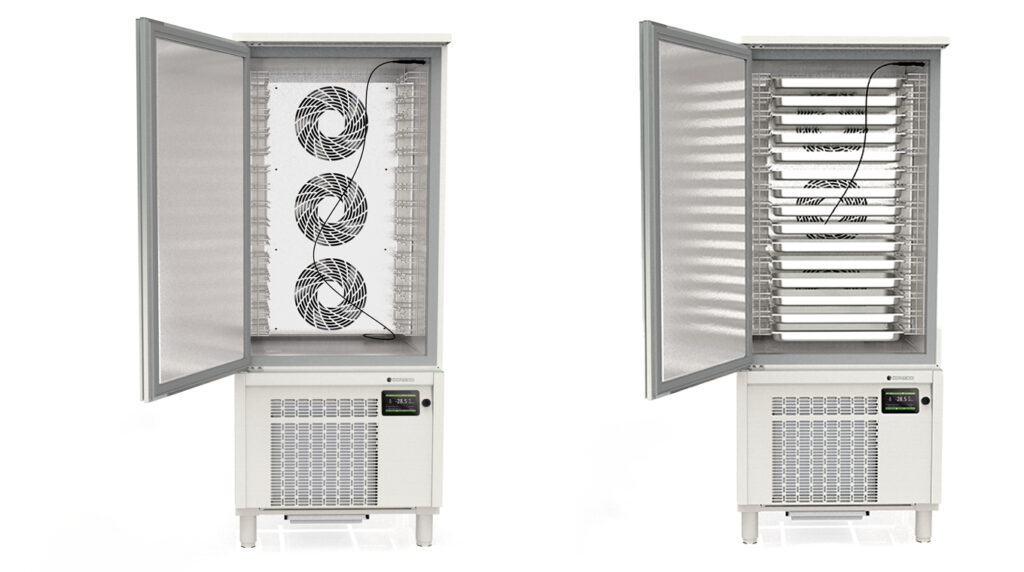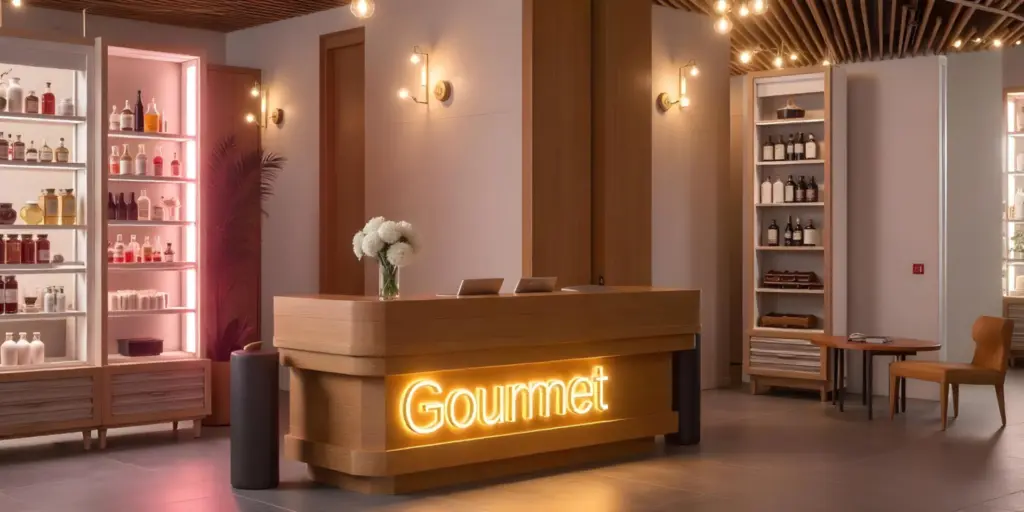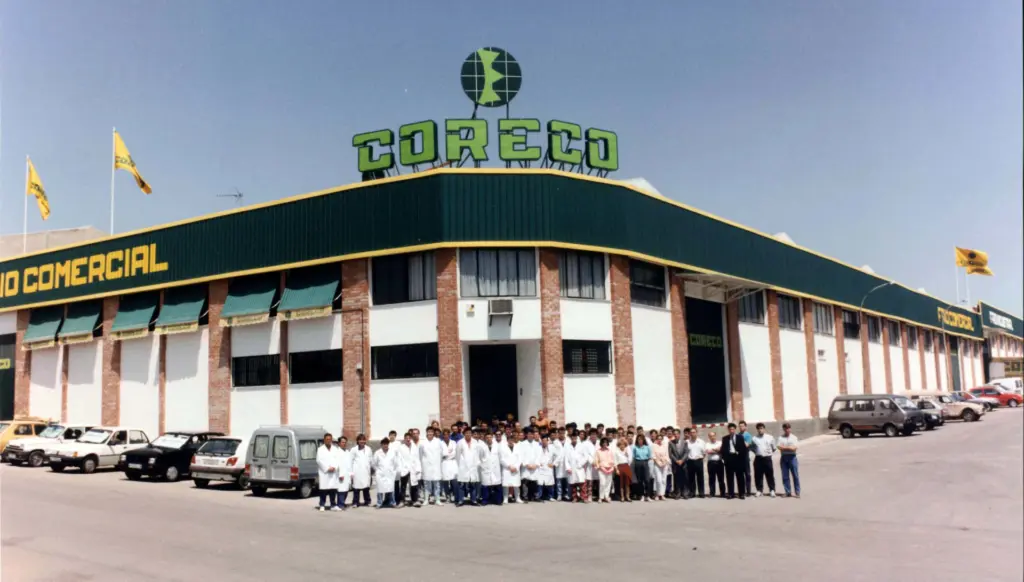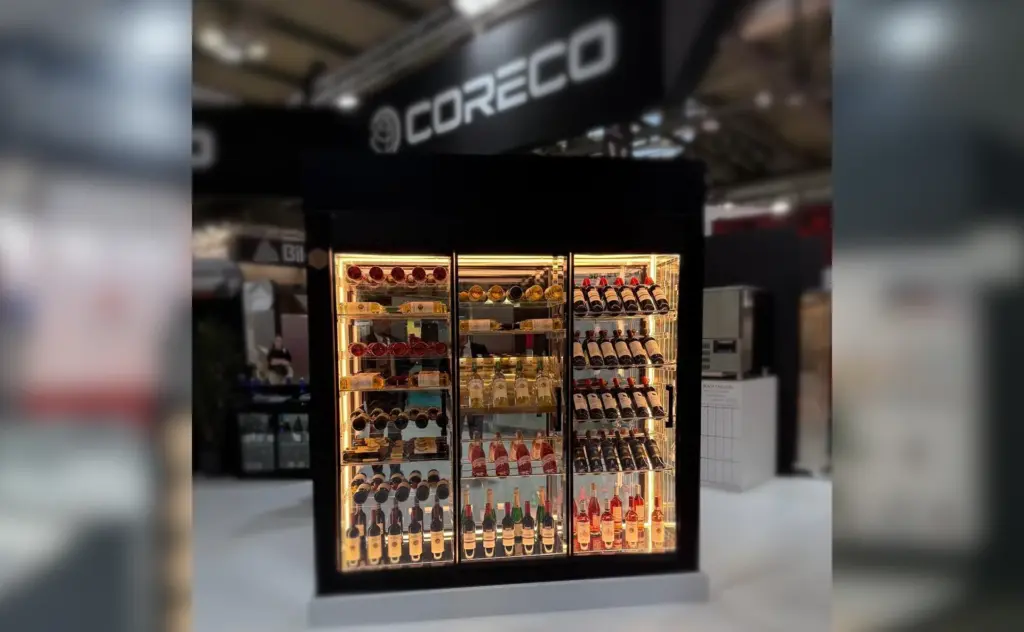Refrigerated display cabinets for tapas and energy labelling
The refrigerated display cabinets for tapas are much more than just preservation equipment. They represent a precise technical solution, designed to keep products ready for consumption in optimal conditions of temperature and presentation. In this article, we explain why these machines are exempt from mandatory energy labellingThe company has developed a new range of products to meet the requirements of the European regulations and, above all, what advantages they offer to distributors and professionals in the Horeca channel. Coreco Gourmet, as a leading manufacturer in sustainable industrial refrigeration, offers equipment adapted to this legal and commercial scenario.
What are refrigerated display cabinets for tapas, sushi and toppings and why are they on the rise?
The refrigerated display cabinets for lids are assisted exposureThe display cases, i.e. closed showcases that are only allowed to be opened by the staff of the establishment. Their main function is to preserving tapas, sushi, toppings and other ready-to-eat foods at a positive temperature (generally between -1 °C and +5 °C), while maintaining an aesthetic and appetising presentation.
Unlike self-service displays, these models:
- They have restricted access (cannot be opened by the customer).
- They use refrigeration statics (without forced ventilation).
- They have a usable volume of less than 200 litres.
- They are designed to conserve rather than sell directly.
Refrigerated display cabinets for tapas, sushi and toppings are equipment designed to preserve and display prepared food or ingredients at optimum temperatures, guaranteeing freshness, food safety and attractive presentation. Their boom in the Horeca sector responds to both the diversification of the gastronomic offer and the growing demand for fresh and visually appealing products.
What are they?
- Refrigerated display cabinets for tapas: They allow to keep tapas cold between +2 °C and +8 °C, ensuring their preservation and avoiding the proliferation of bacteria. They are common in Spanish bars and restaurants, where tapas are the protagonist.
- Sushi display cabinets: Specially designed to preserve sushi and raw fish, delicate products that require stable temperatures and a display that highlights their freshness and colour. They incorporate LED lighting and high quality materials such as stainless steel and tempered glass.
- Display cabinets for toppings: They are used in ice cream parlours, yoghurt parlours, pizzerias and fast food outlets to display ingredients such as fruit, chocolate or nuts, facilitating preparation and self-service.
Main features
- Modern and versatile design: Available in different sizes and styles (curved, straight, customisable), they adapt to the image of the premises and the space available.
- Resistant materials: Made of stainless steel and tempered glass, which guarantees durability and hygiene.
- LED lighting: Improves product visibility and reduces energy consumption.
- Digital temperature control: It allows to adjust and maintain the optimal range for each type of food.
- Compatibility with Gastronorm trays: Facilitates the organisation and replenishment of ingredients or dishes.
- Easy access and cleaning: Sliding doors and pull-out trays make daily service and hygiene quicker.
Why are they booming?
- Gastronomic diversification: The rise of sushi, creative tapas and toppings in modern foodservice has increased the need for specific equipment to preserve and display these products.
- Submission requirement: Consumers value visual presentation; showcases allow food to be displayed attractively, driving impulse sales and improving the perception of quality.
- Food security: Keeping food at the right temperature is essential to comply with regulations and avoid health risks, especially for delicate products such as sushi or egg tapas.
- Service optimisation: They facilitate quick access to products, speeding up preparation and self-service, which is key in premises with high turnover.
- Energy efficiency: The incorporation of energy-efficient technologies and environmentally friendly refrigerants responds to the demand for sustainability in the hospitality industry.
In short, refrigerated display cabinets for tapas, sushi and toppings are a comprehensive solution for the preservation, display and sale of fresh food in the catering industry. Their growth reflects the evolution of the sector towards more visual, safe and efficient proposals.
Main applications in gourmet gastronomy
| Main use | Type of establishment |
|---|---|
| Conservation of cold tapas | Tapas bars, gastrobars |
| Sushi exhibition | Japanese restaurants, sushi bars |
| Presentation of fresh toppings | Restaurants with live cooking, buffets |
| Conservation of ingredients | Open kitchens, plating stations |
This type of display case allows for a neat and tidy presentation, without compromising food safety or the visual appeal of the product.
Why are refrigerated display cabinets for tapas exempt from energy labelling?
Analysis of European legislation: Regulation (EU) 2019/2018 and 2015/1094
The Delegated Regulation (EU) 2019/2018on the energy labelling of refrigeration appliances with a direct sales function clearly defines its scope:
- Article 2.1 requires equipment with direct access by the consumer to be labelled with an energy label.
- Article 1.2 y Annex III exclude closed showcases for assisted service from this obligation.
- The Regulation (EU) 2015/1094This applies only to equipment with a volume greater than 200 L and with active ventilation systems, characteristics that these fume cupboards do not meet.
Therefore, are not subject to energy labelling and do not require registration in the European EPREL database.
In other words, refrigerated display cabinets for tapas are exempted from the obligation to display an energy label mainly because, according to European regulations, they are not considered as vertical or self-service commercial refrigeration equipment, which is subject to this requirement. These cabinets are classified as counter-top or counter-top displays, designed for the temporary display and preservation of food in direct contact with the public, and not for prolonged storage as is the case with refrigerators, freezers or vertical display cabinets.
In addition, many of these cabinets have specific characteristics (such as sliding doors, static or ventilated cooling systems and small dimensions) that place them outside the scope of the energy labelling regulations for commercial refrigeration. Therefore, even if they incorporate efficient technologies such as LED lighting or environmentally friendly refrigerants, they are not required to display the energy label that is required for other types of professional refrigeration equipment.
Equipment table: which are obliged and which are not?
| Type of equipment | Does it require an energy label? | Comment |
|---|---|---|
| Open self-service showcases | ✅ Yes | The client accesses directly |
| Professional refrigerated cabinets | ✅ Yes | Volume >200 L, forced ventilation |
| Refrigerated display cabinets for tapas | ❌ No | Assisted service, static cooling |
Criteria for the exemption of refrigerated display cabinets from energy labelling
Refrigerated display cabinets, especially those used for tapas or in bars, may be exempted from the obligation to display an energy label due to several regulatory and functional criteria set out in the European legislation on eco-design and energy labelling for commercial refrigeration equipment.
Main criteria justifying the exemption:
- Type of device and specific function:
The European regulation (Regulation (EU) 2019/2019 and 2019/2024) applies mainly to medium and low temperature refrigerated cabinets with a direct sales function in supermarkets and retail outlets, such as upright refrigerated cabinets, freezers and wall cabinets. Refrigerated display cabinets for tapas, which are usually table-top cabinets or counter-top displays, are not considered in this category because their main function is temporary storage and display at counters or counters, not long-term storage or direct self-service sales. - Dimensions and net usable volume:
The calculation of energy efficiency is based on the Energy Efficiency Index (EEI), which relates energy consumption to the net useful volume of the equipment. Small display cabinets, with reduced volumes and specific formats for tapas or ingredients, have technical characteristics that make it difficult to apply the standard tests and calculate the EEI according to EN 16825 or UNE-EN ISO 23953-2:2016, which are designed for larger refrigeration units and intensive commercial use. - Conditions for testing and use:
Lidding cabinets do not always operate under the climatic conditions and with the airflow specified in the standards for energy labelling, as their use is more ad hoc and in spaces with direct access to the customer, which implies a different opening and loading regime than standard professional refrigerated cabinets. - Specific exclusions in the regulations:
Some regulations expressly exclude certain types of equipment, such as hot cabinets, display cabinets with circular geometry, or equipment that does not have an integrated system for the production of cold, and also those that are not exclusively electrically operated or that are part of special installations (laboratory, medical, transport). Lid cabinets are usually outside the scope of application due to their particular design and function.
Refrigerated display cabinets for tapas are exempted from the obligation to display an energy label because:
- They are not considered to be direct sales refrigeration units in supermarkets or standard professional refrigerated cabinets.
- Their size, function and conditions of use do not fit into the regulated categories for energy labelling.
- European legislation provides exclusions for specific types of display cabinets and particular uses, including table-top or counter-top display cabinets for tapas.
Therefore, although they incorporate efficient technologies, they are not required to display the energy label that other larger commercial refrigeration units with a traditional direct sales function are required to display.
How to determine if a refrigerated display case needs to be energy labelled
In order to determine whether a refrigerated display case needs an energy label, several criteria established by European regulations on eco-design and energy labelling for commercial refrigeration equipment must be considered:
- Type of equipment and function:
The energy labelling regulations apply mainly to professional refrigerated cabinets, supermarket wall cabinets, ice cream freezers, beverage coolers and refrigerated vending machines, especially those with a direct sales function. Counter-top or counter-top display cabinets for tapas, due to their design and function for temporary storage and counter display, are generally outside these categories. - Calculation of the Energy Efficiency Index (EEI):
If the equipment is included in the regulation, the manufacturer must calculate the EEI, which relates the annual energy consumption to the net usable volume of the appliance, following harmonised standards such as EN 16825 or UNE-EN ISO 23953-2:2016. This calculation determines the energy class (A to G) that must appear on the label. - Conditions of use and design:
Custom-made equipment, open cabinets, counter-top display cabinets, hot cabinets, furniture with circular geometry or equipment that does not run exclusively on electricity are usually excluded. In addition, display cabinets that process food (e.g. ice cream machines) also do not require an energy label. - Current regulations:
Regulation (EU) 2019/2018 and the Ecodesign Regulation (EU) 2019/2024 set out the requirements and exclusions. Only equipment that complies with the definitions and technical conditions of these regulations must carry an energy label.
A refrigerated display case requires an energy label if it falls into the regulated categories (such as upright refrigerated cabinets or wall-mounted display cases for direct sales) and meets the volume, function and conditions of use requirements specified in the regulations. If it is a counter or table-top display case for tapas, it is generally exempt unless the manufacturer has specifically designed and certified it to comply with energy labelling regulations.
What are the advantages of this exclusion for professionals in the sector?
Operational savings, commercial agility and professional aesthetics
The exclusion from energy labelling becomes a technical and commercial benefit. It does not imply less efficiency, but recognises its specialised design and professional scope of use.
Main advantages for the Horeca channel
- No homologation costsNo energy testing or registration of the equipment on European platforms such as EPREL is required.
- Administrative agility: Shorter sales, installation and commissioning times for the equipment.
- Aesthetics without interferenceIt is not compulsory to display visible labels that alter the harmony of the interior design of the establishment.
- Guaranteed regulatory compatibilityThe distributor can assure the end customer that the equipment complies with current legislation without additional formalities.
Selling points for retailers: how to communicate the value of these showcases
How to turn a regulatory objection into a business opportunity
When it comes to closing a sale, the dealer or installer is faced with key questions:
-Why does this equipment not have an energy label?
-How do I know that it complies with the regulations?
-Does it have certified energy efficiency?
Here we present clear, persuasive and technically substantiated sales arguments to answer these questions.
1. Full compliance with European regulations
"The equipment does not have an energy label because it is not required to have one. It is designed for professional use, with restricted customer access and a volume of less than 200 litres, which excludes it from regulation under Regulation (EU) 2019/2018."
💡 Sales tip: Mention the support of a manufacturer such as Coreco, which participates in European standards committees.
2. Guaranteed food security
"Static refrigeration ensures a stable environment for preserving ready-made food. Unlike self-service equipment, assisted access reduces the risk of contamination and improves safety."
💡 Emotional argument: Conveying to the customer that they are investing in a team that will protects consumer health.
3. Real efficiency without a label
"The cabinets are equipped with natural refrigerants R290 or R600a, and their low energy consumption is guaranteed thanks to the use of high-efficiency components such as compressors and high-density thermal insulation."
💡 Sales tip: Shows consumption comparisons with other similar equipment.
4. Silence and design: customer comfort
"As they do not have forced ventilation, the noise level is minimal. This makes them ideal for gourmet spaces, tapas bars, tasting rooms or restaurants with open kitchens".
💡 Key differentiator: In gastronomic experience spaces, silence also sells.
5. Aesthetic customisation and modularity
"The showcases are available in different finishes, sizes and configurations to suit all types of interior design. In addition, they can be combined with other Coreco equipment such as wine cabinets or grab & go displays."
💡 Upselling: Offers modular combinations to expand the installation without compromising design or efficiency.
How do these showcases align with sustainability policies?
Ecological refrigeration adapted to the F-Gas 2024 standard
From 2025, the F-Gas Regulation will limit the use of gases with high Global Warming Potential (GWP). Coreco's refrigerated display cabinets for lids are already fully adaptedusing natural refrigerants:
- R290 (propane) y R600a (isobutane) with GWP ≤ 3.
- No forced ventilation = lower energy consumption.
- HFC- and ODP-free injected polyurethane insulation.
Coreco's environmental commitment
Coreco manufactures under ISO 14001 certification, with processes that reduce CO₂ emissions at all stages: design, production and use of the equipment.
How to choose the ideal refrigerated display case for tapas, sushi or toppings?
| Factor to consider | Technical recommendation |
|---|---|
| Product type | Cold tapas, sushi, sensitive ingredients |
| Volume required | Less than 200 litres in most applications |
| User access | Premises staff only |
| Noise level | Low or none, ideal for gourmet spaces |
| Aesthetics | Optional in black steel, stainless steel or custom lacquering |
| Applicable regulations | EU Regulation 2019/2018 and 2015/1094 (non-mandatory) |
Frequently asked questions about refrigerated display cabinets for tapas
Can I install them on counters that are open to the customer?
Yes, as long as the customer does not have direct access to the interior. These are assisted service counters.
What maintenance do they require?
- Cleaning of surfaces and glass.
- Thermostat check.
- Verification of compressor and magnetic seals.
Can they be personalised?
Yes, at Coreco we offer customisable versions in terms of finishes, measurements and components, such as LED lighting or additional shelves.
Conclusion: refrigerated display cabinets for tapas - a regulatory, commercial and operational ally
The refrigerated display cabinets for tapas are equipment designed with a specific technical logic: to store ready-to-eat products with restricted access, in a stable temperature environment and without noise or excessive consumption. Their exclusion from energy labelling is not a limitationbut an advantage based on its regulatory specialisation.
At Coreco Gourmet, we develop display cabinets that rigorously comply with European standards, incorporate environmentally friendly technology and bring concrete commercial advantages to retailers. For the Horeca sector, this means efficiency, compliance and aesthetic differentiationin a single product.











